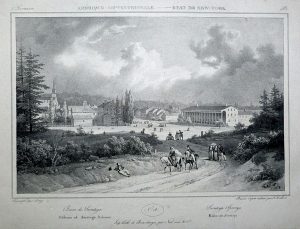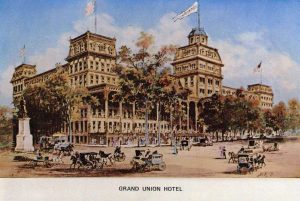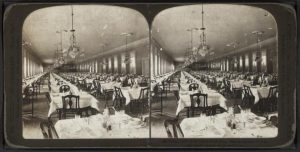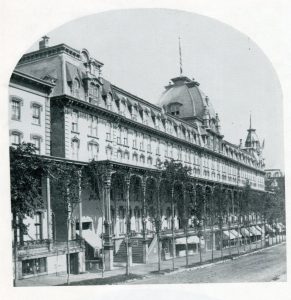
Postcard of Saratoga Village, 1829
As racing season nears and the crowds on Broadway grow, it is hard to imagine what the crowds of strollers would have been like in 1874, the only season that all four of the grand resort hotels on Broadway were open – Congress Hall, the Grand Central Hotel, the Grand Union Hotel, and the United States Hotel. In addition to the usual crowds in town for the springs, the races, and casino, that year thousands would be visiting to attend the first inter-collegiate regatta on Saratoga Lake. It was an exciting year in Saratoga Springs!
Saratoga Springs was far different in 1874 than in 1803 when Gideon Putnam opened the first hotel. Seeing an opportunity, Putnam purchased an acre of land next to Congress Spring from Henry Walton, a judge and large landowner, in 1802. The three-story building, Putnam’s Tavern and Boarding House, was often referred to by the locals for its “pretentiousness” and his “optimism and ambition” since at the time the village only had a few log cabins. Putnam was a visionary who set out to establish a resort community in the wilderness. Seeing the potential where others did not, he bought more land from Walton, an additional 130 acres adjacent to the original acre he purchased. It was Putnam, who laid out the first streets of Saratoga Springs, including the 120’ wide Broad Street, which today is known as Broadway.
 Much to the surprise of those who had referred to Putnam’s Tavern and Boarding House as a folly, it was a success. Shortly after it opened, he expanded the hotel to include a parlor, dining room, and a ballroom. The hotel was expanded to more than twice its original size by the time of Putnam’s death in 1812, when he fell overseeing the construction of a second hotel, Congress Hall. Following his death, Putnam’s wife Doanda operated the boarding house. Prior to her death in 1836, it was renamed Union Hall. Putnam’s heirs operated Union Hall and continued to expand it.
Much to the surprise of those who had referred to Putnam’s Tavern and Boarding House as a folly, it was a success. Shortly after it opened, he expanded the hotel to include a parlor, dining room, and a ballroom. The hotel was expanded to more than twice its original size by the time of Putnam’s death in 1812, when he fell overseeing the construction of a second hotel, Congress Hall. Following his death, Putnam’s wife Doanda operated the boarding house. Prior to her death in 1836, it was renamed Union Hall. Putnam’s heirs operated Union Hall and continued to expand it.
In 1864, the Leland Brothers purchased the hotel. They renamed it the Grand Union Hotel, dramatically changed its appearance to the popular at the time Second Empire architectural style with broad piazzas, and built a 1,600 seat opera house and private “cottages” for the wealthy on the hotel’s grounds. When the Leland Brothers defaulted on the mortgage, A. T. Stewart acquired it. Stewart’s desire was to make it the grandest and most complete summer hotel in the world. He purchased ten additional properties on the block to expand it. He built the north half of the front of the hotel to match the south half of the hotel to extend from Congress Street to Washington Street; constructed a 200’ north wing on the site of the cottages, and extended the south wing west to Federal Street for a length greater than 500’. “No expense was spared,” according to Nathaniel Bartlett Sylvester’s “History of Saratoga County, New York.” By 1878, it could serve nearly 2,000 guests and was considered one of the largest hotels in the world.

Dining Room of the Grand Union, year unknown.
Congress Hall was completed following Putnam’s death. It had 140’ feet fronting on Broadway with a rear wing. Congress Hall soon became the place for “leading fashionables” to be as it was the first to have bands and a schedule of balls. After a series of owners, it was no longer successful and the Honorable Henry Hathorn purchased the property in 1854. He and his partner, H.P. Hale, made a series of improvements including a ball room on the corner opposite the hotel on Spring Street. It was during the construction of the ballroom that the Hathorn Spring was discovered. Unfortunately, the hotel suffered a devastating fire in 1866. The new brick and brownstone hotel built in the Second Empire style had accommodations for nearly 1,000, It had 416’ fronting Broadway with a grand piazza “commanding a view of the most brilliant portion of Saratoga,” according to Sylvester. It had two 300’ wings – the north wing along Spring Street overlooked the Hathorn and Hamilton Springs and the south wing had views of a beautiful enclosed garden on one side and on the other a stunning view of Congress Park.
The third of the grand hotels on Broadway, the United States Hotel, was built in 1824 by Elias Benedict. It was four stories and had 120’ frontage along Broadway between Washington and Division Streets. Over the years, ownership changed and additions were made. After the hotel burned down in 1865,. the owners – James M. Marvin, Judge Thomas J. Marvin, and Lewis Benedict constructed a new hotel on the site that opened on June 20, 1874. The Second Empire style hotel was six stories in height with a 232’ piazza on Broadway and enclosed seven acres. The narrow piazza along Division Street was referred to as “Millionaires Row” because as many as 20 of the nation’s wealthiest men would meet there. It could accommodate more than 2,000 guests with 768 sleeping rooms and 65 cottages, each with a parlor, bath-room, water closet, and one to seven bedrooms. The “cottage wing” was most desirable as it provided families and other parties quiet seclusion but with all the attention and conveniences of a first-class hotel.

Depiction of the Grand Central Hotel, year unknown.
The grand hotel on Broadway with the shortest existence was the Grand Central Hotel. It opened the summer of 1872 and was lost to fire after the summer season of 1874. The hotel was erected at the southwest corner of Broadway and Congress Street on the site of the Crescent Hotel that had burned. Charles R. Brown, the owner of the Crescent Hotel who was also an optician and jeweler, went into partnership with Dr. Robert Hamilton, a well-respected doctor in the community, to build the new hotel. The Second Empire style Grand Central Hotel was designed by J.D. Stevens, who also designed the United States Hotel, and was able to accommodate over 1,000 guests. It had its own private spring and views overlooking Congress Park. It was said that the owners had financial troubles and in debt to many. On October 1, 1874 in broad daylight the hotel caught fire and with gusting winds threatened the Grand Union Hotel and Congress Hall. According to newspaper accounts, the blame of the fire was put on “some malicious person” who perhaps had their motives as it was rumored that many people who constructed the building had not yet received their pay and that “some unknown person may have burned the building for revenge.”
Founded in 1977, the Saratoga Springs Preservation Foundation is a private, not-for-profit organization that promotes preservation and enhancement of the architectural, cultural and landscaped heritage of Saratoga Springs. To learn more or to join, please visit www.saratogapreservation.org.
